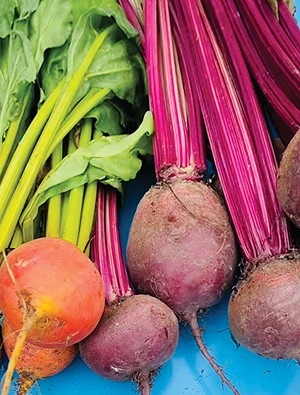According to a recent survey, beets are the second most disliked vegetable in Am erica, second only to turnips. Even the Obamas hate beets – so much that they insisted that no beets were to be planted in the White House vegetable garden. Yet beets are one of our most nutritious vegetables and are extremely popular in many other culinary cultures. The New York Times ranks beets number one in their list of "The 11 Best Foods You Aren't Eating."
There are several reasons why this vegetable is so maligned. Fresh beets tend to taste earthy, like the soil they're grown in, though when cleaned and cooked properly, that earthy taste goes away. Beets are messy. They can stain your hands and cutting board and clothes. Beets are inconvenient, requiring 45 minutes to 1 hour to cook.
As an adult, I love beets, but my current love affair with this root vegetable got off to a rocky start. I surmise that a person's aversion to certain vegetables has its roots in bad cooking. My early childhood experiences were with canned beets, a bit of an underwhelming experience. I remember being forced to try my grandmother's horrendous Harvard beets, which were canned beets swimming in a thick sweet and sour sauce made from sugar, vinegar and cornstarch. When I finally tasted beets that were cooked properly, I discovered how delicious this root vegetable could be, and I contend that good cooking techniques can turn most beet-haters into beet-lovers.
The nutritional benefits of beets are extraordinary. They're loaded with B vitamins, minerals and fiber. As a bonus, if you are lucky enough to find freshly harvested beets, the beet tops are also delicious and nutritious. The dark leafy greens are high in calcium, vitamins and iron.
The flavor and nutritional value of beets vary with cooking techniques. You can boil them, steam them, roast them or grill them. When you boil beets, you will lose a lot of nutrients into the cooking water. Steaming will retain more nutrients than boiling. Slow-roasting beets in a foil packet or covered baking dish takes away much of the earthy taste and intensifies the flavor, but you will still have a bit of bleeding and nutrient loss. Grilling beets over wood or charcoal will add a layer of smokiness.
To retain the vegetable's nutrients and color, beets should be cooked without peeling first. Once the beets are cool enough to handle, the skins can be easily rubbed off with paper towels. Use gloves if you have them, to avoid staining your hands, and lightly rub off the skin from the stem end to the root with the paper towels. If you get beet juice on your hands, rub your hands with wet salt and lemon juice and then wash with soap and water. Clean your cutting board with a bleach solution.
Beets have a high water content and, when cooked, the water turns into steam and is driven out, taking with it flavor, pigmentation and nutrients. Water has no flavor and salting draws out the water. I have found that slow-roasting beets in salt allows the water to escape, but leaves behind the color and flavor and nutrients. The result is a more intensely flavored vegetable. This technique also works well with other root vegetables such as carrots. When I'm not in a hurry, slow-roasting in salt is my preferred method to cook beets.
To prepare beets for cooking, cut off the greens leaving about ½ inch of the stems. Beets bleed easily, and this will help minimize nutrient loss. Cut off the taproot and leaves, saving the greens to prepare in the same manner as Swiss chard. Trim off any stringy roots. Scrub them thoroughly with a brush to remove any dirt and rinse thoroughly.
Salt-Roasted Beets
Serve these as a side dish or in a salad. Beets pair nicely with orange segments, goat cheese and almonds.
Ingredients
Beets – tops trimmed, leaving 1/2 inch of the stems
Kosher salt
Rosemary or thyme sprigs
Preparation
Preheat the oven to 425 degrees.
Fill a baking dish with a 1/2-inch layer of kosher salt.
Trim and scrub the beets, but do not dry. Roll the wet beets in the salt until thoroughly coated. Arrange the beets on the salt bed, and nestle thyme or rosemary sprigs between the beets. Cover the baking dish tightly with foil and roast in the oven for 45 minutes to an hour. Cooking times will vary with the size of the beets. The beets are done when a knife tip or skewer can be inserted into the center without much resistance.
When cool enough to handle, remove the skins with paper towels.
Sauteed Beet Greens
One pound of beet greens will yield about 2 cups cooked
Ingredients
Beet tops
1 small onion, chopped
2 cloves garlic, minced
1 tablespoon olive oil
Kosher salt
Red pepper flakes
Preparation
Wash the beet tops in cold water. Separate the greens from their stems. Slice the stems into ½-inch pieces and roughly chop the greens. Heat a couple tablespoons of cooking oil in a large skillet over medium heat. Add the stems, onions and garlic and cook for about 5 minutes. Do not let the garlic burn. Add the beet greens to the pot a handful at a time and cook down until wilted and most of the water has evaporated. Season to taste with salt and a pinch of red pepper flakes.


